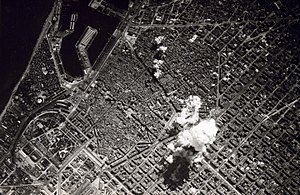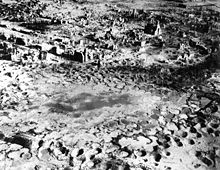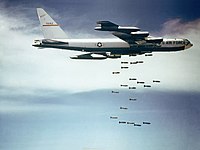Carpet bombing


Carpet bombing, also known as saturation bombing, is a large area bombardment done in a progressive manner to inflict damage in every part of a selected area of land.[1][2][3][4] The phrase evokes the image of explosions completely covering an area, in the same way that a carpet covers a floor. Carpet bombing is usually achieved by dropping many unguided bombs.
Carpet bombing of cities, towns, villages, or other areas containing a concentration of protected civilians has been considered a war crime since 1977,[5] through Article 51 of Protocol I of the Geneva Conventions.[6][7][8]
The term obliteration bombing is sometimes used to describe especially intensified bombing with the intention of destroying a city or a large part of the city. The term 'area bombing' refers to indiscriminate bombing of an area and also encompasses cases of carpet bombing, including obliteration bombing. It was used in that sense especially during World War II and the Korean War.[9]
Early history
One of the first attempts at carpet bombing was at the
In March 1938, the Bombing of Barcelona saw Italian and German airstrikes killing up to 1,300 people and wounding 2,000. It is considered the first carpet bombing of a city,[12][failed verification] and set a precedent for several such bombings in World War II.
The Japanese bombing of China's wartime capital Chongqing from 18 February 1938 to 23 August 1943 caused 23,600 deaths and over 30,000 wounded.[citation needed]
During World War II
Pre-war expectation
In the inter-war years, a growing expectation developed that, on the outbreak of war, cities would be rapidly destroyed by bombing raids. The use of poison gas was expected and a high level of devastation was anticipated from high explosive bombs. This originated, in part, from the views of military experts such as Douhet, and was taken up by politicians and journalists, with, for example, Stanley Baldwin coining the phrase "‘The bomber will always get through’. The targeting of the civilian population would, some theories suggested, cause a breakdown in morale that would lead to civil unrest that would compel a government to surrender. The combatant powers could, according to Baldwin, be in a competition to break the morale of the other side's civilian population first.[13]
There were two results from this. Firstly, civil defence programs were set up, with gas masks being issued, plans for air raid shelters were set up and organisations to manage civilians before a raid and deal with damage and casualties after one were put in place. Secondly, agreements were sought to make the targeting of civilians illegal under international law. At the time that Douhet and others were publishing their ideas, no air force had planned their capabilities with the intent of making a "knockout blow" against civilian targets.[13] The Hague Rules of Air Warfare were developed in 1922/23 to prevent deliberately attacking civilians, yet it was not ratified by any country.[14] At the start of World War II, the Royal Air Force had an initial instruction to abide by the Hague Rules for as long as the enemy did.[citation needed] This restraint was followed by both Britain and Germany until 11 May 1940, when, with Winston Churchill now in the role of Prime Minister and the war in France going badly, the RAF attacked industrial and transport infrastructure targets in Mönchengladbach. This raid caused civilian casualties.[15]
Bombing by Germany
In the
As the war progressed, the Battle of Britain developed from a fight for air supremacy into the strategic and aerial bombing of London, Liverpool, Coventry and other British cities.
Bombing by the Western Allies
The Nazis entered this war under the rather childish delusion that they were going to bomb everyone else, and nobody was going to bomb them. At Rotterdam, London, Warsaw, and half a hundred other places, they put their rather naive theory into operation. They sowed the wind, and now they are going to reap the whirlwind.
Cologne, Lubeck, Rostock—Those are only just the beginning. We cannot send a thousand bombers a time over Germany every time, as yet. But the time will come when we can do so. Let the Nazis take good note of the western horizon. There they will see a cloud as yet no bigger than a man’s hand. But behind that cloud lies the whole massive power of the United States of America
Arther Harris, after the 1,000 bomber raid on Cologne
At the beginning of war, RAF Bomber Command lacked both the navigation systems for finding a target and the numbers of bombers that were needed to make attacks of any scale in Germany.
As heavy bombers were brought into service and technology and tactics were improved, the selection of targets was changed. The intention of avoiding civilian casualties as collateral damage disappeared. Instead, the civilian population which worked in war-related industries – and their housing – became the target.
Some of this change came from a wish to retaliate for the German attack on Coventry.[a] It was also based on what was learnt from being the target in the Blitz. It had been found that factory buildings were more resistant to critical damage than the homes of their workers. Absenteeism of the workforce rose significantly if their housing was uninhabitable, so affecting industrial production. Whilst morale was still discussed, the meaning of the word changed from its pre-war usage. Now a reduction in morale was intended to reduce industrial production that supported the war effort.[19] The area bombing directive was issued to RAF Bomber Command in 1942
The Eighth Air Force of the USAAF arrived in Britain over the summer of 1942. Despite Roosevelt's pleas to Hitler to avoid bombing civilians prior to the US joining the war, he was a supporter of bombing Germany. Both Churchill and Roosevelt were in the position that Stalin was pressing for the Western Allies to open a new front in Europe – something which they were not ready to do. Therefore a bombing campaign - the Combined Bomber Offensive - following the Casablanca directive to the Allied air forces was all they could offer to support the Soviet Union.
Operation Gomorrah carried out by Bomber Command
Carpet bombing was also used as
Pacific War
In the
During the final months of the war in the Philippines, the United States military used carpet bombing against the Japanese forces in
Vietnam War
During the

The B-52s were restricted to bombing suspected Communist bases in relatively uninhabited sections, because their potency approached that of a tactical nuclear weapon. A formation of six B-52s, dropping their bombs from 30,000 feet (9,100 m), could "take out"... almost everything within a "box" approximately five-eighths mile (1.0 km) wide by two miles (3.2 km) long. Whenever Arc Light struck ... in the vicinity of Saigon, the city woke from the tremor..
Neil Sheehan, war correspondent, writing before the mass attacks to heavily populated cities including North Vietnam's capital.[36]
Beginning in late 1965, a number of B-52Ds underwent Big Belly modifications to increase bomb capacity for carpet bombings.
The zenith of B-52 attacks in Vietnam was Operation Linebacker II (sometimes referred to as the Christmas Bombing) which consisted of waves of B-52s (mostly D models, but some Gs without jamming equipment and with a smaller bomb load). Over 12 days, B-52s flew 729 sorties[41] and dropped 15,237 tons of bombs on Hanoi, Haiphong, and other targets.[42] Originally 42 B-52s were committed to the war; however, numbers were frequently twice this figure.[43]
See also
- Aerial bombardment and international law
- Aerial bombing of cities
- Area bombardment
- Bombing of Warsaw in World War II
- Churchill's advocacy of chemical strike against German cities
- Civilian casualties of strategic bombing
- Giulio Douhet, an early theorist of bombing
- Roerich Pact
- Strategic bombing
- Tactical bombing
- Terror bombing
Notes
References
- ^ "carpet-bombing". Memidex/WordNet Dictionary. Archived from the original on 28 January 2013. Retrieved 25 July 2011.
- ISBN 1-59114-429-9.
- ISBN 1-57488-710-6.
- ISBN 0-7146-4680-6.
- ^ "Crimes of War – Carpet or Area Bombing". Archived from the original on 2 December 2015. Retrieved 8 December 2015.
- Britannica.com. Retrieved 21 June 2019.
- ^ "Treaties, States parties, and Commentaries - Additional Protocol (I) to the Geneva Conventions, 1977 - 51 - Protection of the civilian population". International Committee of the Red Cross. 8 June 1977. Retrieved 21 June 2019.
- ^ "Treaties, States parties, and Commentaries - Additional Protocol (I) to the Geneva Conventions, 1977 - 51 - Protection of the civilian population - Commentary of 1987". Paragraph 5. International Committee of the Red Cross. Retrieved 21 June 2019.
- ISBN 978-1-84545-687-0.
- ^ Juan Antonio de Blas, "El Mazuco (La defensa imposible)" (pp369–383), in La guerra civil en Asturias, Ediciones Júcar, Gijón 1986.
- ^ "El Mazuco (The Impossible Defense)". www.speleogroup.org. Translated by Mike Cowlishaw. Retrieved 21 June 2019.
- OCLC 53806663.
- ^ a b Overy 2013, p. 19-37.
- ^ Overy 2013, p. 29.
- ^ Overy 2013, p. 239, 243.
- ISBN 978-1-78023-608-7.
- ^ Hooton 2007, p. 52.
- ^ Overy 2013, p. 262.
- ^ Overy 2013, p. 255-259, 264.
- ^ Overy 2013, p. 255-259, 282, 391.
- )
- ISBN 0-275-94319-4.
- ^ "Tokyo remembers 1945 bombing raid". BBC News. 10 March 2005. Retrieved 1 April 2010.
- ^ Colhoun, Jack. "Strategic Bombing". Institute for Energy and Environmental Research. Retrieved 21 June 2019.
- ^ ISBN 978-0-415-58377-0.
- ^ Selden, Mark (2007). "A Forgotten Holocaust: US Bombing Strategy, the Destruction of Japanese Cities & the American Way of War from World War II to Iraq". The Asia-Pacific Journal: Japan Focus. 5.
The Strategic Bombing Survey estimated that 87,793 people died in the raid, 40,918 were injured, and 1,008,005 people lost their homes. Robert Rhodes, estimating the dead at more than 100,000 men, women and children, suggested that probably a million more were injured and another million were left homeless.
- ^ Selden, Mark (2007). "A Forgotten Holocaust: US Bombing Strategy, the Destruction of Japanese Cities & the American Way of War from World War II to Iraq". The Asia-Pacific Journal Japan Focus. 5.
Overall, by one calculation, the US firebombing campaign destroyed 180 square miles of 67 cities, killed more than 300,000 people and injured an additional 400,000, figures that exclude the atomic bombing of Hiroshima and Nagasaki.
- ISBN 978-3-030-24823-9. Retrieved 22 August 2023.
- ISBN 978-0-8147-9791-4.
- ISBN 978-1-317-50650-8. Retrieved 28 March 2022.
- ISBN 978-1-351-73424-0. Retrieved 28 March 2022.
- ^ Lake International Air Power Review Summer 2003, p. 103.
- ^ Anderson, William. "Guam Jets Bomb S. Viet." Archived 17 June 2013 at the Wayback Machine Chicago Tribune, 18 June 1965.
- ^ Hobson 2001, pp. 22–23.
- ^ Schlight 1988, p. 52.
- ^ Condor 1994, p. 37.
- ^ Lake & Styling 2004, p. 30.
- ^ a b Dick & Patterson 2006, p. 161.
- ^ Knaack 1988, p. 256.
- ^ Donald 1997, pp. 161–162.
- ^ Dick & Patterson 2006, p. 187.
- ^ Condor 1994, p. 38; Budiansky 2004, p. 394.
- ^ Lake & Styling 2004, p. 32.
Bibliography
- Budiansky, Stephen (2004). Air Power: The Men, Machines, and Ideas that Revolutionized War, from Kitty Hawk to Iraq. New York: Penguin Books. ISBN 978-0-670-03285-3.)
{{cite book}}: CS1 maint: location missing publisher (link - Condor, Albert E (1994). Air Force Gunners (AFGA): The Men Behind the Guns, The History of Enlisted Aerial Gunnery, 1917–1991. Nashville, Tennessee: Turner Publishing. ISBN 978-1-56311-167-9.
- Dick, Ron; Patterson, Dan (2006). Aviation Century: War & Peace In The Air. Eden Prairie, Ontario: Boston Mills Press. ISBN 978-1-55046-430-6.
- Donald, David (1997). The Encyclopedia of World Aircraft. Etobicoke, Ontario, Canada: Prospero Books. ISBN 978-1-85605-375-4.
- Hobson, Chris (2001). Vietnam Air Losses, USAF, USN, USMC, Fixed-Wing Aircraft Losses in Southeast Asia 1961–1973. North Branch, Minnesota: Specialty Press. ISBN 978-1-85780-115-6.
- Hooton, E. R. (2007). Luftwaffe at War; Blitzkrieg in the West. London: Chevron/Ian Allan. ISBN 978-1-85780-272-6.
- Knaack, Marcelle Size (1988). Post-World War II Bombers, 1945–1973 (PDF). Washington, D.C.: Office of Air Force History. ISBN 978-0-16-002260-9.
- Lake, Jon; Styling, Mark (2004). B-52 Stratofortress Units in Combat 1955–73. London: Osprey Publishing. ISBN 978-1-84176-607-2.
- ISBN 978-0-141-92782-4.
- Schlight, John (1988). The War in South Vietnam: The Years of the Offensive, 1965–1968 (The United States Air Force in Southeast Asia). Washington, D.C.: Office of Air Force History, United States Air Force. ISBN 978-0-912799-51-3.
External links
- "Bombs Over Cambodia" from The Walrus
